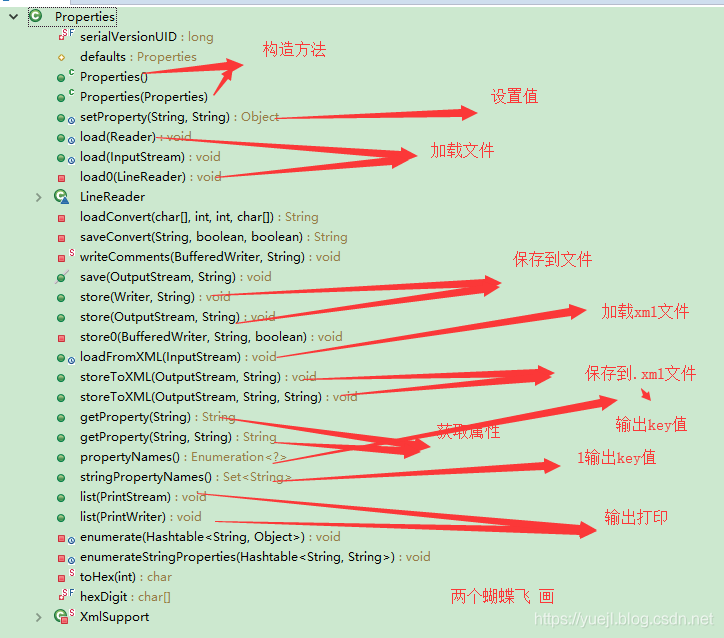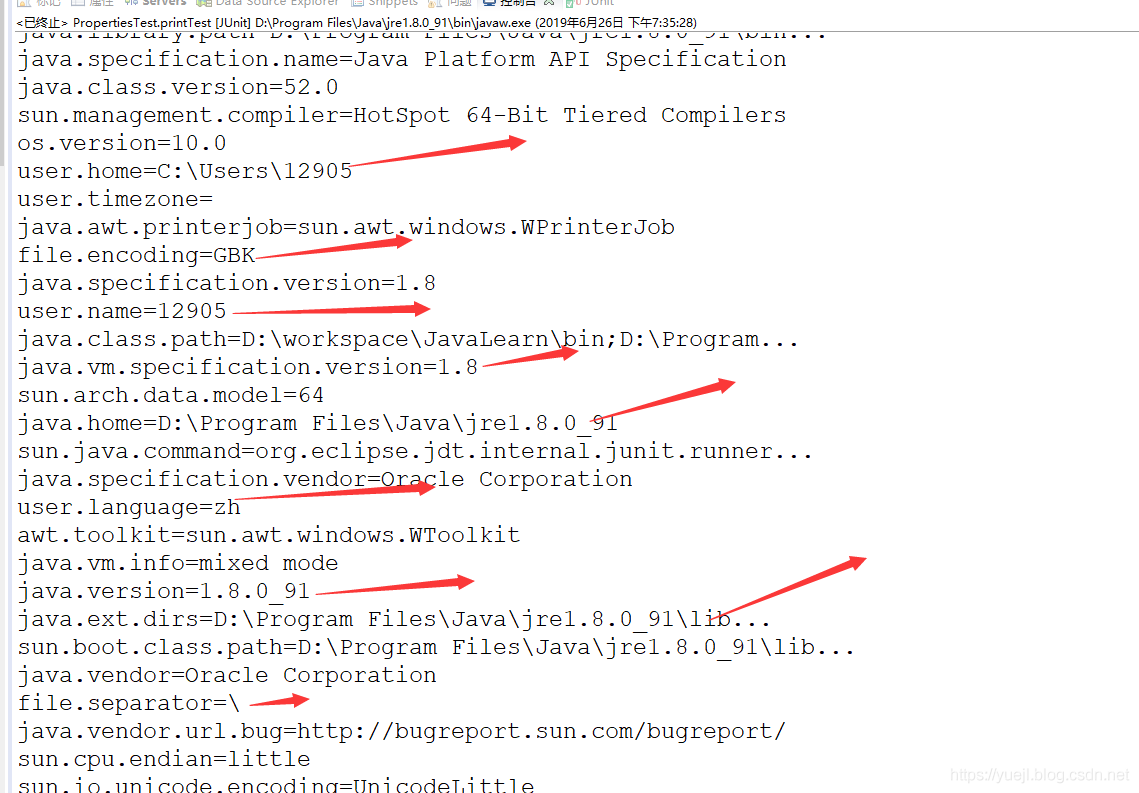我把你的头像,设置成我的名字,此刻你便与我同在。
我把你的名字,写进我的代码里面,以后,我的世界便存在着你。
Properties 类位于 java.util.Properties ,是Java 语言的配置文件所使用的类, Xxx.properties 为Java 语言常见的配置文件,如数据库的配置 jdbc.properties, 系统参数配置 system.properties。 这里,讲解一下Properties 类的具体使用。
以key=value 的 键值对的形式进行存储值。 key值不能重复。

继承了Hashtable 类,以Map 的形式进行放置值, put(key,value) get(key)
主要方法:

这里只讲解一些常用的形式。
JVM 中可以获取Properties, 来打印输出 JVM 所了解的属性值。
用list() 方法,打印到控制台。
@Test
public void printTest(){
Properties properties=System.getProperties();
properties.list(System.out);
}
常见的有:

在src 目录下,放置 jdbc.properties 文件,是数据库的配置文件。
jdbc.driver=com.mysql.jdbc.Driver jdbc.url=jdbc:mysql://localhost:3306/mybatis?characterEncoding=utf8 jdbc.username=root jdbc.password=abc123
@Test
public void name1Test(){
try{
Properties properties=new Properties();
//用的是磁盘符的绝对路径
InputStream input=new BufferedInputStream(new FileInputStream("D:\\workspace\\JavaLearn\\src\\jdbc.properties"));
properties.load(input);
properties.list(System.out);
}catch(Exception e){
e.printStackTrace();
}
}
url 被截取了。

@Test
public void name2Test(){
try{
Properties properties=new Properties(); // 用/文件名, / 表示根目录
InputStream input=PropertiesTest.class.getClass().getResourceAsStream("/jdbc.properties");
properties.load(input);
Enumeration<String> names=(Enumeration<String>) properties.propertyNames();
while(names.hasMoreElements()){
//这是key值
String key=names.nextElement();
String value=properties.getProperty(key);
System.out.println(key+"="+value);
}
}catch(Exception e){
e.printStackTrace();
}
}

@Test
public void name3Test(){
try{
Properties properties=new Properties();
//直接写src 类路径下的文件名
InputStream input=PropertiesTest.class.getClassLoader().getResourceAsStream("jdbc.properties");
properties.load(input);
//把key值转换成set 的形式,遍历set
Set<String> names=properties.stringPropertyNames();
Iterator<String> iterator=names.iterator();
while(iterator.hasNext()){
String key=iterator.next();
String value=properties.getProperty(key);
System.out.println(key+"="+value);
}
}catch(Exception e){
e.printStackTrace();
}
}

@Test
public void name3Test(){
try{
Properties properties=new Properties();
InputStream input=PropertiesTest.class.getClassLoader().getResourceAsStream("jdbc.properties");
properties.load(input);
//String value=properties.getProperty("jdbc.url");
String value=properties.getProperty("jdbc.url1","没有该key值");
System.out.println("输出值:"+value);
}catch(Exception e){
e.printStackTrace();
}
}
输出时,getProperty() 有当前的key值,则输出Key值对应的value 值。
如果没有key值,则输出 null 值。
后面可以跟 default 值,如果没有该值,则输出设置的默认值。

@Test
public void writeTest(){
try{
Properties properties=new Properties();
InputStream input=PropertiesTest.class.getClassLoader().getResourceAsStream("jdbc.properties");
properties.load(input);
//多添加几个值。
properties.setProperty("name","两个蝴蝶飞");
properties.setProperty("sex","男");
//properties.put("name","两个蝴蝶飞"); 可以用继承Hashtable 的put 方法写入值
// properties.put("sex","男");
//将添加的值,连同以前的值一起写入 新的属性文件里面。
OutputStream out=new FileOutputStream("D:\\jdbc.properties");
properties.store(out,"填充数据");
}catch(Exception e){
e.printStackTrace();
}
}

在构建输入流和输出流时,指定编码格式, 编码的格式相同。 如均是 utf-8的形式。
@Test
public void write2Test(){
try{
Properties properties=new Properties();
//用绝对路径
InputStream input=new BufferedInputStream(new FileInputStream("D:\\workspace\\JavaLearn\\src\\jdbc.properties"));
properties.load(new InputStreamReader(input,"utf-8"));
//多添加几个值。
properties.setProperty("name","两个蝴蝶飞");
properties.setProperty("sex","男");
OutputStream output=new FileOutputStream("D:\\jdbc.properties");
OutputStreamWriter out=new OutputStreamWriter(output,"utf-8");
properties.store(out,"填充数据");
}catch(Exception e){
e.printStackTrace();
}
}
测试运行之后:

这样便解决了乱码的问题。
将Properties 类中定义的属性,导出成 .xml 的形式.
@Test
public void xmlWriteTest(){
try{
//处理成编码样式。
Properties properties=new Properties();
//多添加几个值。
properties.setProperty("name","两个蝴蝶飞");
properties.setProperty("sex","男");
OutputStream output=new FileOutputStream("D:\\jdbc.xml");
//编码设置成utf-8的形式。
properties.storeToXML(output,"填充到xml","utf-8");
}catch(Exception e){
e.printStackTrace();
}
}
测试结果为:

用 <entry> 节点 key为属性, 后面跟值来进行输入。
可按照这种形式,继续添加。
@Test
public void xmlReadTest(){
try{
Properties properties=new Properties();
InputStream input=new BufferedInputStream(new FileInputStream("D:\\jdbc.xml"));
properties.loadFromXML(input);
properties.list(System.out);
}catch(Exception e){
e.printStackTrace();
}
}

这就是Properties 类的常见用法 。